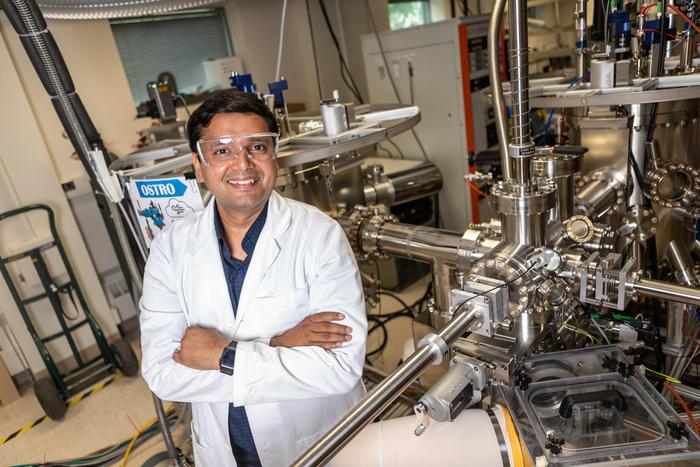In a groundbreaking development that could reshape the future landscape of advanced computing and information storage, researchers at the University of Minnesota Twin Cities have unveiled a startling magnetic phenomenon within one of the thinnest metallic oxide materials ever synthesized. This discovery not only challenges long-held assumptions about the magnetic properties of well-known compounds but also heralds promising prospects for the next generation of spintronic devices and quantum technologies, where the manipulation of electron spin and quantum states is paramount.
The material at the heart of this revelation is ruthenium dioxide (RuO₂), a compound traditionally recognized for its metallic but nonmagnetic nature. By employing a sophisticated materials fabrication method called hybrid molecular beam epitaxy, the research team succeeded in growing atomically thin films of RuO₂ with unparalleled precision. This technique allowed them to engineer ultrathin layers—merely two-unit cells thick—that retain metallicity while exhibiting emergent magnetic characteristics previously unseen in bulk form.
Central to this magnetic transformation is the application of epitaxial strain — a process analogous to stretching or compressing a highly elastic object, but executed at the atomic scale. The team manipulated the lattice structure of the RuO₂ films during growth, causing distortions in atomic positioning and electron interactions. The strain effectively modulates the material’s electronic band structure, unlocking an altermagnetic state. This novel phase of magnetism possesses distinct symmetry and spin arrangements that differentiate it sharply from traditional ferromagnetism or antiferromagnetism, placing RuO₂ among the pioneers of this fresh class of magnetic materials.
One of the most compelling manifestations of this magnetic state is the anomalous Hall effect observed in the ultrathin RuO₂ films. Unlike in conventional metals where this effect is either absent or requires intense magnetic fields, the researchers detected significant transverse deflection of electrical current under relatively weak magnetic fields. This phenomenon is critical for engineering future memory and logic elements, as it enables the control of charge flow through spin configurations, potentially leading to devices that are faster, more compact, and far more energy efficient than today’s silicon-based electronics.
The discovery sets a new benchmark in materials science because the RuO₂ films maintain extraordinary metallic conduction while simultaneously exhibiting complex magnetic behavior. Bharat Jalan, a professor of chemical engineering and materials science at the University of Minnesota and senior author of the study, emphasized the uniqueness of the finding: “At the atomic scale, RuO₂ reveals itself as one of the most metallic materials we have ever observed in an oxide system, maintaining conductivity levels that rival elemental metals and even graphene, which is widely regarded as the ultimate 2D metal.” He further elucidated the significance of demonstrating an altermagnetic phase experimentally for the first time in such a system, underscoring the potential for inventive applications.
Equally impactful is the stability of these atomically thin films as they sustain their structure without succumbing to degradation, a notable challenge in 2D and ultrathin materials research. This structural robustness ensures that the unique properties of the material can be reliably tapped in practical applications. Postdoctoral researcher and first author, Seunnggyo Jeong, highlighted the practical relevance by asserting, “This is not merely a theoretical or laboratory phenomenon. Our findings pave the way for integration into real-world devices with transformative implications for the fields of artificial intelligence and beyond.”
The team’s collaborative effort spanned multiple specialties, incorporating advanced characterization and theoretical modeling techniques to unravel the underlying mechanisms of the observed behavior. Tony Low, a co-author and professor in electrical and computer engineering, contributed sophisticated calculations that verified how precisely tuned strain conditions distort the crystal lattice and electronic interactions to foster the altermagnetic phase in RuO₂. These insights solidify the relationship between mechanical manipulation at the atomic scale and emergent quantum magnetic phenomena.
Excitingly, the researchers are already envisioning a future where such ultrathin magnetic metals become integral components of quantum computing architectures, spintronic memory devices, and ultra-low power electronics. By layering and combining materials with tailored strain profiles, it may be possible to design platforms with customized electronic and magnetic functionalities optimized for specific technological needs. This direction promises to accelerate the realization of devices that surpass current limits in speed, efficiency, and miniaturization.
The collaborative nature of the study featured contributions from experts in both chemical engineering and electrical engineering fields, including team members Zhifei Yang, Sreejith Nair, Rashmi Choudhary, Juhi Parikh, and Seungjun Lee, alongside institutional collaborators at the Massachusetts Institute of Technology and international partners at Gwangju Institute of Science and Technology and Sungkyunkwan University. Together, their interdisciplinary approach leveraged state-of-the-art synthesis and measurement tools provided by the University of Minnesota Characterization Facility and was supported by funding from the U.S. Department of Energy and the Air Force Office of Scientific Research.
Published in the highly prestigious and peer-reviewed journal, Proceedings of the National Academy of Sciences (PNAS), this study not only extends fundamental scientific understanding of metal oxides and magnetism but also invigorates the quest for next-generation device materials that underpin the emerging digital economy. As the push towards artificial intelligence and quantum computing intensifies, materials like the epitaxially-strained RuO₂ films could emerge as indispensable building blocks.
In summation, the discovery that atomically thin RuO₂ films can exhibit metallicity alongside an unprecedented altermagnetic state facilitated by epitaxial strain reshapes our comprehension of oxide materials. It opens the door to exploiting emergent quantum phenomena for practical engineering solutions in computing and information technology. Continued exploration of strain-driven phases and ultrathin materials synthesis stands to revolutionize electronics by unveiling materials capable of performing beyond the constraints of conventional paradigms.
Subject of Research: Magnetic properties of epitaxially strained, atomically thin RuO₂ films and their implications for spintronics and quantum computing
Article Title: Metallicity and anomalous Hall effect in epitaxially strained, atomically thin RuO₂ films
News Publication Date: 16 June 2024
Web References:
- PNAS article
- University of Minnesota Materials Research Science and Engineering Center (MRSEC)
- University of Minnesota Characterization Facility
Image Credits: Credit: University of Minnesota
Keywords: Magnetism, Materials science, Thin films, Spintronics, Quantum computing




